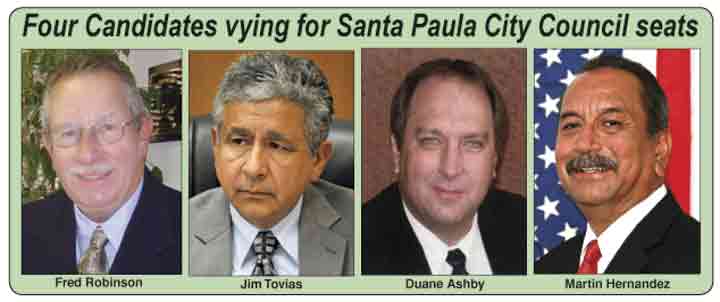First Candidates Forum features 3 of the 4 candidates
August 31, 2012
By Peggy Kelly
Santa Paula News
During an at times edgy exchange, three candidates for the Santa Paula City Council met for the first time at a forum held at the Knights of Columbus Hall.
The August 23 forum was sponsored by Latino Town Hall and CAUSE, and was moderated by former Mayor Dr. Gabino Aguirre. Candidate Duane Ashby was unable to make the forum due to business travel, but incumbents Fred Robinson and Jim Tovias as well as challenger Martin Hernandez were on hand to ask forum pre-prepared as well as audience asked questions.
Forum organizers had presented the questions in advance to the candidates that included plans for bringing jobs to the city, future street repairs, and candidate opinions on Proposition 30, the statewide measure facing voters November 6 that would raise the state’s sales tax by one-quarter cent and increase income taxes on the wealthy; it is projected that the measure could help to close a $16 billion state budget gap. Each candidate had three minutes to introduce themselves before the questions started.
Hernandez, a Ventura County native and Santa Paula resident for 18 years, said he started public service as a U.S. Air Force medic who later worked in the family farm labor contracting business, which employed more than 100 people. The business generated a $1 million payroll and gave Hernandez “the opportunity to gain respect” for farm workers and their hard work.
Hernandez later went into social services, first overseeing the opening and then directing the Santa Paula Family Resource Center before joining the office of Supervisor Kathy Long 11 years ago. Now Long’s chief of staff, Hernandez also oversees the local tattoo removal program that “changes many lives by helping them get back into the mainstream,” which also opens the doors to employment.
Robinson, a native Santa Paulan who returned to live in the city, has made social services his career: he has been the CEO of nonprofit The Arc for 22 years and will be retiring at the end of the year. “It is time,” said Robinson, “to move on to the next chapter of my life.”
Robinson said he is seeking a second term on the council to “complete the work that started four years ago.” He said among his “proudest achievements... through very collaborative work” including council, was tackling a projected $1.8 million General Fund budget deficit. The city also “resolved some issues” regarding affordable housing, settled the longtime lawsuit filed by CEDC, and approved projects that served housing needs of the disabled and elderly and tackled street projects.
Tovias is also a city native who returned to live in the city. He said he worked his way through college and gave up a job as a corporate insurance executive to run his own agency to provide stability for his family.
“Our council guided the city through one of the toughest periods,” when a $1.8 million deficit was projected that “turned in a surplus.” Tovias said the city’s financial consultant Dr. Tom Gardner told him and the city manager “he was using the plan as a model for other cities in similar situations.”
Tovias said when he was mayor the council passed the school unification resolution: “I see it bringing good companies and good jobs” to the area. He also noted the completion of the bike trail, and noted, “There is a lot of work to be done, a lot of big projects coming, and every decision I have made” was not for personal gain, but for the good of the city.
Trade union representative Rodney Cobos of Santa Paula noted that unemployment is the highest in Santa Paula among other county residents, and asked if the candidates would adopt a benefit agreement for local hiring for public projects.
“The key phase here is publicly funded,” said Tovias. And because Santa Paula is a general law city the council can’t impose such rules although, he claimed, “This council has a good record working with local labor.”
“I think it’s important to hire locally first” and use as much influence on developers as legally allowable, said Hernandez, who urged that the city beat development to the punch by having policy on the books that would deal with such projects. He also urged that more job training be brought to the city to have workers prepared to take the jobs that will come with a strengthening economy.
Robinson agreed with Tovias’ claim that “we are precluded by law” from developing council labor agreements, although, “We do have the power of bully pulpit” to pressure developers into using local labor.
When it came to support of statewide Proposition 30, “Absolutely, I support it,” said Hernandez, especially as it makes education a funding priority and would help restore badly battered community pride. “People on the streets are telling me there’s no pride left,” he noted.
“I haven’t seen any documentation that taxing millionaires will solve problems,” said Tovias, who opposes Proposition 30. “You just can’t keep taking people with money.... They’ll leave,” and he criticized across the board spending on the state level. “Something has to stop, something has to change or this hole will get deeper and deeper and deeper,” he said.
Robinson sided with Hernandez and said he would support the proposition, although “I don’t like it.” Robinson said although proud of area schools, “It’s not right that” the state is now ranked 47th in the nation for per student spending, especially when California used to lead the list in educational excellence and accomplishment.



